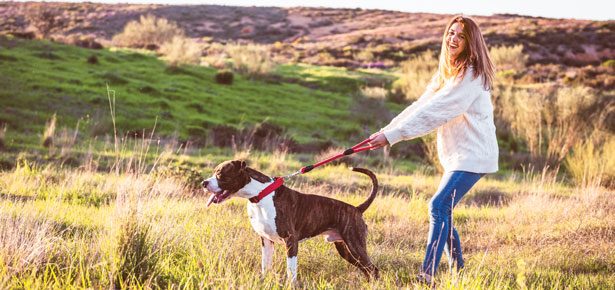

Teach Your Dog the Magic “Touch”
Have a dog-reactive dog or a pup that pulls ahead on leash? Here’s why you teach your dog targeting
Most dog owners understand why it’s important to teach basic behaviours such as sit, lie down, stay, and come. But when it’s suggested to teach a dog touch—otherwise known as targeting—they often look confused. Let me explain. “Touch” is a verbal cue that means you would like your dog to touch something with a part of his body. The most common form of targeting is for a dog to touch his nose to a person’s hand. Why, you might ask, would anyone want to teach that? Although it might sound strange, the skill actually comes in very handy (sorry, couldn’t help myself!) in quite a few situations.
Teaching the skill is easy and straightforward. Grab a few treats, and hold them in one hand behind your back. Face your dog. Present the empty hand to your dog with palm flat, pointed toward the ground. The back of your hand should be just below and to the side of your dog’s nose, close enough that he can easily reach to sniff it. Most dogs will immediately sniff the hand to check things out. At the moment his nose makes contact say, “Yes!” and give a treat from the other hand. Repeat the exercise, making sure not to move your hand to touch your dog’s nose; the goal is that he makes the motion himself. Vary the placement of your hand from one side of his nose to the other in subsequent repetitions, but don’t place it above his nose. If your dog doesn’t investigate the hand when initially presented, try bringing it back to your waist and presenting it again. If that doesn’t work, hold a treat between your thumb and first finger with the hand flat, palm down. Chances are your dog will
be happy to check out the hand now! When he does, flip it over and let him have the treat. Once he gets the idea, you won’t need to keep a treat in that hand.
Once you’ve done enough repetitions that you’re confident your dog will touch his nose to the hand as soon as it’s within range, it’s time to add the verbal cue. Say, “Touch!” just before presenting your hand. You can lose the “Yes!” at this point. Of course, if your dog successfully touches the hand with his nose, give a treat.
“Touch” is useful in a variety of situations. It can be used to teach your dog to walk nicely next to you, and is helpful when walking a dog who is reactive toward other dogs or people. Start by standing with your dog on the side you’d like him to walk on. You should both be facing the same direction. Standing in place, do a few repetitions of touches, rewarding each success with a treat. Next, take one step forward and immediately bring your hand down to ask for the touch, and treat. Continue along this way, asking for touches with every few steps. Don’t leave your hand dragging along as you walk; rather, keep both hands either at your hips or chest (whichever is more comfortable) so that you can present the hand each time while keeping treats out of reach. It takes a bit of practice to achieve a smooth walking/targeting motion, but once you get going, you’ll find that your dog is in proper position by your side as you walk along together. If your dog is reactive toward other dogs on walks, doing touches as soon as you spy another dog and continuing as you pass each other will give your dog something to focus on, and will keep him in a cognitive frame of mind rather than spiraling out of control emotionally.
Hand targeting has other uses as well. If your dog is nervous at the vet, do hand touches as you sit in the waiting room so that anxiety doesn’t build. If possible, do them as well while the vet examines your dog. I have done this with dogs who don’t appreciate being handled or vaccinated, and it makes things easier on everyone. If your dog is afraid of a particular person, touch can be transferred from you to that person. My book Help for Your Fearful Dog has step-by-step instructions, but the overall idea is that once your dog knows the skill, you would sit next to the person and ask for a few touches, then place your hand over the person’s hand and ask for touches. Gradually, things would shift to the person’s hand being on top of yours for the touches, and finally, your dog would do touches to that person’s hand by itself. Touch can even be transferred from touching your hand to touching an object your dog fears. In both of these scenarios, the power to decide whether to approach and touch is in your dog’s own paws, which makes all the difference in overcoming a fear. Again, you’ll be surprised at how simple hand targeting is to teach, and how useful it is in a variety of situations. So, get training!
Join the newsletter and never miss out on dog content again!
"*" indicates required fields
By clicking the arrow, you agree to our web Terms of Use and Privacy & Cookie Policy. Easy unsubscribe links are provided in every email.





